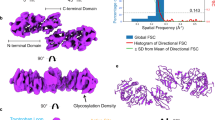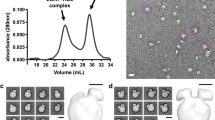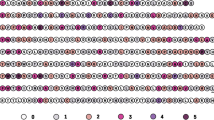Abstract
The low-density lipoprotein receptor (LDLR) is the primary mechanism for uptake of cholesterol-carrying particles into cells. The region of the LDLR implicated in receptor recycling and lipoprotein release at low pH contains a pair of calcium-binding EGF-like modules, followed by a series of six YWTD repeats and a third EGF-like module. The crystal structure at 1.5 Å resolution of a receptor fragment spanning the YWTD repeats and its two flanking EGF modules reveals that the YWTD repeats form a six-bladed β-propeller that packs tightly against the C-terminal EGF module, whereas the EGF module that precedes the propeller is disordered in the crystal. Numerous point mutations of the LDLR that result in the genetic disease familial hypercholesterolemia (FH) alter side chains that form conserved packing and hydrogen bonding interactions in the interior and between propeller blades. A second subset of FH mutations are located at the interface between the propeller and the C-terminal EGF module, suggesting a structural requirement for maintaining the integrity of the interdomain interface.
This is a preview of subscription content, access via your institution
Access options
Subscribe to this journal
Receive 12 print issues and online access
$189.00 per year
only $15.75 per issue
Buy this article
- Purchase on Springer Link
- Instant access to full article PDF
Prices may be subject to local taxes which are calculated during checkout




Similar content being viewed by others
Accession codes
References
Goldstein, J.L. & Brown, M.S. J. Biol. Chem. 249, 5153–5162 (1974).
Brown, M.S. & Goldstein, J.L. Science 232, 34–47 (1986).
Brown, M.S. & Goldstein, J.L. Proc. Natl. Acad. Sci. USA 71, 788–792 (1974).
Yamamoto, T. et al. Cell 39, 27–38 (1984).
Sudhof, T.C., Goldstein, J.L., Brown, M.S. & Russell, D.W. Science 228, 815–822 (1985).
Sudhof, T.C., Russell, D.W., Goldstein, J.L. & Brown, M.S. Science 228, 893–895 (1985).
Springer, T.A. J. Mol. Biol. 283, 837–862 (1998).
Davis, C.G. et al. Nature 326, 760–765 (1987).
Willnow, T.E., Nykjaer, A. & Herz, J. Nature Cell Biol. 1, E157–162 (1999).
Herz, J., Gotthardt, M. & Willnow, T.E. Curr. Opin. Lipidol. 11, 161–166 (2000).
Herz, J., Clouthier, D.E. & Hammer, R.E. Cell 71, 411–421 (1992).
Hafen, E., Basler, K., Edstroem, J.-E. & Rubin, G.M. Science 236, 55–63 (1987).
Simon, M.A., Bowtell, D.D.L. & Rubin, G.M. Proc. Natl. Acad. Sci. USA 86, 8333–8337 (1989).
Hiesberger, T. et al. Neuron 24, 481–489 (1999).
Trommsdorff, M. et al. Cell 97, 689–701 (1999).
Wehrli, M. et al. Nature 407, 527–530 (2000).
Pinson, K.I., Brennan, J., Monkley, S., Avery, B.J. & Skarnes, W.C. Nature 407, 535–538 (2000).
Tamai, K. et al. Nature 407, 530–535 (2000).
Moult, J. Curr. Opin. Biotechnol. 10, 583–588 (1999).
Murzin, A.G. Proteins Struct. Func. Genet. 14, 191–201 (1992).
Sondek, J., Bohm, A., Lambright, D.G., Hamm, H.E. & Sigler, P.B. Nature 379, 369–374 (1996).
Wall, M.A. et al. Cell 83, 1047–1058 (1995).
Lambright, D.G. et al. Nature 379, 311–319 (1996).
Willnow, T.E. J. Mol. Med. 77, 306–315 (1999).
Conte, L.L., Chothia, C. & Janin, J. J. Mol. Biol. 285, 2177–2198 (1999).
ter Haar, E., Musacchio, A., Harrison, S.C. & Kirchhausen, T. Cell 95, 563–573 (1998).
Sprague, E.R., Redd, M.J., Johnson, A.D. & Wolberger, C. Embo J. 19, 3016–3027 (2000).
Goldstein, J.L., Hobbs, H.H. & Brown, M.S. In The metabolic and molecular bases of inherited disease, Vol. 2 (eds. Scriver, C.S., Beaudet, A.L., Sly, W.S. & Valle, D.) 1981–2030 (McGraw Hill Inc., New York; 1995).
Wilson, D.J. et al. Am. J. Cardiol. 81, 1509–1511 (1998).
Varret, M. et al. Nucleic Acids Res. 26, 248–252 (1998).
Fox, J.W. et al. EMBO J. 10, 3137–3146 (1991).
Otwinowski, Z. & Minor, W. Methods Enzymol. 276, 307–326 (1997).
Brunger, A.T. et al. Acta Crystallogr. D 54, 905–921 (1998).
Jones, T.A., Zou, J.Y., Cowan, S.W. & Kjeldgaard, M. Acta Crystallogr. A 47, 110–119 (1991).
Lamzin, V.S. & Wilson, K.S. Acta Crystallogr. D 49, 129–147 (1993).
Gotoh, O. J. Mol. Biol. 264, 823–838 (1996).
Sali, A. & Blundell, T.L. J. Mol. Biol. 234, 779–815 (1993).
Koradi, R., Billeter, M. & Wuthrich, K. J. Mol. Graph. 14, 51–55, 29–32 (1996).
Nicholls, A., Sharp, K.A. & Honig, B. Proteins 11, 281–296 (1991).
Kraulis, P.J. J. Appl. Crystallogr. 24, 946–950 (1991).
Acknowledgements
We thank J.-H. Wang for helpful discussions, F. Poy for assistance with computer graphics, S.E. Choe for the program homology, and C. Heaton and the staff at CHESS for assistance with synchotron data collection on beamline A1. This research is supported by NIH grants to S.C.B, T.A.S. and M.J.E. S.C.B. is a Pew Scholar in the Biomedical Sciences. This work is based upon research conducted at the Cornell High Energy Synchrotron Source (CHESS), which is supported by the National Science Foundation, using the Macromolecular Diffraction at CHESS (MacCHESS) facility, which is supported by the National Institutes of Health.
Author information
Authors and Affiliations
Corresponding author
Rights and permissions
About this article
Cite this article
Jeon, H., Meng, W., Takagi, J. et al. Implications for familial hypercholesterolemia from the structure of the LDL receptor YWTD-EGF domain pair. Nat Struct Mol Biol 8, 499–504 (2001). https://doi.org/10.1038/88556
Received:
Accepted:
Issue Date:
DOI: https://doi.org/10.1038/88556
This article is cited by
-
Novel LDLR variants affecting low density lipoprotein metabolism identified in familial hypercholesterolemia
Molecular Biology Reports (2024)
-
GBA1-dependent membrane glucosylceramide reprogramming promotes liver cancer metastasis via activation of the Wnt/β-catenin signalling pathway
Cell Death & Disease (2022)
-
Mutation type classification and pathogenicity assignment of sixteen missense variants located in the EGF-precursor homology domain of the LDLR
Scientific Reports (2020)
-
Exosomal arrow (Arr)/lipoprotein receptor protein 6 (LRP6) in Drosophila melanogaster increases the extracellular level of Sol narae (Sona) in a Wnt-independent manner
Cell Death & Disease (2020)
-
Molecular definition of the interaction between a tumor-specific tetrabranched peptide and LRP6 receptor
Amino Acids (2020)



